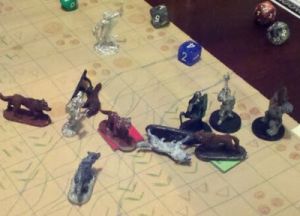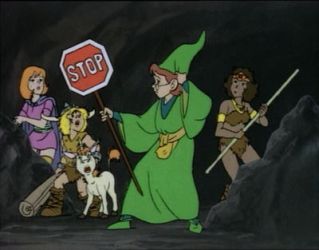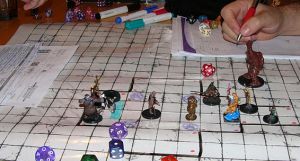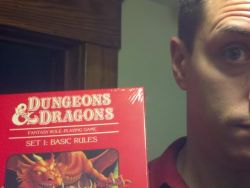Three Suggestions for 5th Edition Dungeons & Dragons
February 8, 2011 - Games
The debate about whether 4th Edition D&D is better than 3.5 has become as epic an internet grudge as the battle between Playstation and XBox or the battle between cake and pie. I've been running a 4th edition game for just under a year now, but I've owned every edition of D&D back to my first red box set back in 1983. I'm not writing today to discuss which edition is better. I'm writing to examine the best achievements and worst failings of each edition and consider what might work well for the future of the game.
 When Wizards of the Coast announced that there would be a 3.5 edition of the game, it turned a lot of people off. They're going to make us buy more books just for some lousy rules revisions? This turned a lot of folks off, but was generally (if grudgingly) accepted. When 4th edition came out, the nature of the rules revisions turned even more people off. Then came Essentials, which many have mistaken for a 4.5 edition of D&D. 4th Edition has done a lot right, but they've also done a lot wrong.
When Wizards of the Coast announced that there would be a 3.5 edition of the game, it turned a lot of people off. They're going to make us buy more books just for some lousy rules revisions? This turned a lot of folks off, but was generally (if grudgingly) accepted. When 4th edition came out, the nature of the rules revisions turned even more people off. Then came Essentials, which many have mistaken for a 4.5 edition of D&D. 4th Edition has done a lot right, but they've also done a lot wrong.
If Wizards of the Coast is considering a 5th Edition, they really need to ask themselves how to win back the customers that they lost when they moved from 3.5 to 4th Edition. I understand the plusses and minuses of the OGL. Allowing that kind of openness led to the same kind of information glut evident on the internet, and a lot of poor-quality material surfaced. With no quality control and no rules standards, groups that adopted 3rd-party material soon found their games to be unbalanced and overpowered. But 4th edition overcompensated, and owning all the necessary materials can be prohibitively expensive.
Keeping these things in mind, here are my three suggestions for Wizards of the Coast, or for whomever ends up purchasing the D&D name from them, when designing a 5th edition of the game.
1. Move away from MMO mechanics
Yes, I know how popular World of Warcraft is. Yes, I know that the DPS/Tank/Healer mechanic works very well for what it does, and I know that it's been shaped over time ever since Ultima Online and  Everquest gave us concepts like aggro and DPS. But as a straight translation, it detracts from D&D. The traditional D&D fighter wasn't always just a defender, and the traditional thief wasn't always just a striker. Many PC classes were defined more by what they could do outside of combat as what they could do in a fight. Thieves were defined by thief skills. Magic-Users were defined by their spell list, which included far more than just combat powers. I don't want to get too deep into what I'll discuss later here, but people tend to roleplay far more when sitting around a table than they do when sitting in front of a PC.
Everquest gave us concepts like aggro and DPS. But as a straight translation, it detracts from D&D. The traditional D&D fighter wasn't always just a defender, and the traditional thief wasn't always just a striker. Many PC classes were defined more by what they could do outside of combat as what they could do in a fight. Thieves were defined by thief skills. Magic-Users were defined by their spell list, which included far more than just combat powers. I don't want to get too deep into what I'll discuss later here, but people tend to roleplay far more when sitting around a table than they do when sitting in front of a PC.
Sitting and playing 4th edition D&D feels very different than playing second or third edition. It feels closer to a board game or video game than a true role-playing game. I think it's possible to take some cues from MMO games without becoming one, but this leads me into my second suggestion.
2. Make the game less gamist
If you look at all tabletop roleplaying games on a scale from most realistic to most gamey, a game like GURPS would sit at one end of the scale. GURPS is very realistic. So much so that it takes a long time to play and figure out the details of what happens, and characters die very easily. You know what? It's not as fun to play a game where any random schmuck with a knife can kill your epic hero. But that's realism. On the other side of the scale lies D&D 4th edition. Things like healing surges, returning instantly from near-death, and a nonmagical power that allows the warlord to grant his ally a free action aren't very realistic. But they can be fun, and they work well for the game. Still, I feel that Wizards of the Coast has gone a bit too far in the gamist direction. I suppose it's not a surprise when you consider that the design decision is coming from the same folks who gave us Magic: The Gathering. Making games is what they do. And a game that's the farthest thing from realism is maybe something that needed to be out there, you know, in the world. But it doesn't feel right for D&D. I think D&D needs to sit a bit further towards the middle of the scale, and I'm not even suggesting that it be in the center. Just a tad bit more realistic, as I feel that the ridiculous things that happen as a result of 4th edition rules often detract from the game.
Magic items don't feel magical. At all. It used to be that people would complain that +1 swords didn't feel special. Now, that +2 rod of smiting is something that you're expected to have by the time you reach 6th level - it's in the rules. If you didn't have it, the game wouldn't be balanced! They even put the whole list of magic items in the Players Handbook!
 Another issue that has been addressed by the 4th edition ruleset is that of overpowered high-level characters. It's always been the case in the past that characters above 8th level or so become very hard for a DM to manage. Spells like passwall and teleport can be campaign-breakers. This is largely because most DMs don't stop to consider that in a world where such spells exist, people would take steps to better defend against their use. A king who can be killed in his sleep by any mage with a teleport spell and a knife won't stay king for long. But 4th edition D&D largely removes this kind of spell from the game. Generally these spells are rituals, requiring expensive components and a lot of time. While I very much enjoy the notion of rituals, I heartily disagree with the decision to remove any spells not suited to combat from a spellcaster's primary powers list. What of using phantasmal force or detect invisible in a battle? What of escaping via a shadow door? What about using a fly spell to get up to that ledge and throw down magic missiles from a safe distance?
Another issue that has been addressed by the 4th edition ruleset is that of overpowered high-level characters. It's always been the case in the past that characters above 8th level or so become very hard for a DM to manage. Spells like passwall and teleport can be campaign-breakers. This is largely because most DMs don't stop to consider that in a world where such spells exist, people would take steps to better defend against their use. A king who can be killed in his sleep by any mage with a teleport spell and a knife won't stay king for long. But 4th edition D&D largely removes this kind of spell from the game. Generally these spells are rituals, requiring expensive components and a lot of time. While I very much enjoy the notion of rituals, I heartily disagree with the decision to remove any spells not suited to combat from a spellcaster's primary powers list. What of using phantasmal force or detect invisible in a battle? What of escaping via a shadow door? What about using a fly spell to get up to that ledge and throw down magic missiles from a safe distance?
I'm all for making the game equally playable at 25th level as it is at 5th, and the creation of three tiers of play is a good idea, but I'm not sure it's being handled optimally. Higher-level characters back in 2nd edition used to have to worry about medusai that could turn you to stone with a glance, beholders with disintegration eyes, and kobolds with 20-or-death poison. The flipside of that coin was that resurrection was available at every corner store. My group hasn't ever played that way, but then again, my group hasn't often played games above 10th level or so. While listening to the Return to Northmoor podcast this morning, I heard one of the guys say that playing at 18th level feels just like playing at 5th level, only with better special effects. His meaning was that it took the fighter just about the same number of hits to take down a monster, and he hit just about as often. The numbers just slowly slide up a scale and the game feels static. I don't feel that it's a requirement for the game to become more difficult from a player perspective as the characters' levels progress, even though that might be realistic. I just think that the feel of the game needs to change somehow. Paragon and Epic tiers do change the rules enough to change the feel a bit, but I can't shake the feeling that D&D has lost something.
3. Make the character classes separate yet equal
No, I'm not referencing outdated segregation policy here, I'm trying to say that the game's character classes should be equally powerful, yet have entirely different and separate powers and roles. And as stated above, I don't mean Defender, Striker, Leader, although it wouldn't be entirely bad to have different character classes that incorporate different elements of these. You could go a number of places with these. You could take a page from the Ultima IV virtues and create eight base character classes from defense/attack/healing in the same way that Ultima created eight virtues from truth, love, and courage. Or you could simply create three base classes in the same way that Dragon Age: Origins did, merging the mage with the cleric. The thief's new backstab mechanic in that game made them valuable strikers at the same time as it made tactical positioning paramount. 4th Edition defines a number of monster roles that partially parallel player roles: Soldiers and controllers have the equivalent PC class roles, but leader becomes an add-on that can be applied to any other role, and striker is split out into many monster roles. The skirmisher focuses on movement, the brute on offense over defense, and the artillery on ranged combat. These are great roles that break out of the traditional healer/tank/dps model. And the lurker, who attacks and then fades away, may be my favorite of the bunch. He sacrifices attacking every round for that big punch that may come only a few times in each combat. That would make a great new tactic for a 5th Edition thief class. Likewise, using the brute model for barbarians, skirmisher for ranger, and splitting the abilities of a leader could work well. Leaders can heal, buff, and grant extra actions. Why not let the clerics heal and fight, let the mages buff and act as artillery, and let some other class grant actions, maybe via a mini-haste spell? There are many ways you could go with this, and I'm just brainstorming.
Part of the problem is that every class has powers, and a ranged arrow attack power that stuns is effectively identical to a ice bolt that stuns. When every class has powers, no class is unique at all. No longer do thieves have thief skills and wizards spells. In earlier editions, low-level mages were useless after casting their one or two spells, and thieves were always underpowered in combat. Fighters got boring to play when all you'd do every round is swing a sword. 4th edition's solution was to give every class a list of powers. The least powerful would be infinitely usable, and the most powerful usable once per day, just like a wizard's spell. Balanced, but horribly unrealistic that a fighter could only swing his sword that way once until he got a good night's sleep. And worst of all, it makes every character class feel exactly the same as every other character class. They need to be equally powerful, but different. Kind of like Starcraft.
 Yeah, Starcraft. I think the biggest thing that made Starcraft as popular as it has been over the past decade is the fact that Blizard created three totally different races with very different units and play styles, but kept them perfectly balanced. That's what D&D needs. Even if it only came up with three and split character classes off of those three bases (fighter/thief/mage, perhaps?) then we'd have a great basis for a new edition of the game. The thing about this type of a system is that it requires a ton of playtesting to balance correctly. Blizzard patched Starcraft for years after its release. And as we've learned, the practice of releasing patch notes as pdf files (even online) for 4th edition D&D is a big mess. It's just not easy to integrate all that information. The way it should be done is via an online reference system. And 4E's online implementation, as great as it sounded when we all heard about what it would do, has turned out to stink. Like old tube socks. WotC may be good at publishing and distributing great-looking books and trading cards, but they suck at software development.
Yeah, Starcraft. I think the biggest thing that made Starcraft as popular as it has been over the past decade is the fact that Blizard created three totally different races with very different units and play styles, but kept them perfectly balanced. That's what D&D needs. Even if it only came up with three and split character classes off of those three bases (fighter/thief/mage, perhaps?) then we'd have a great basis for a new edition of the game. The thing about this type of a system is that it requires a ton of playtesting to balance correctly. Blizzard patched Starcraft for years after its release. And as we've learned, the practice of releasing patch notes as pdf files (even online) for 4th edition D&D is a big mess. It's just not easy to integrate all that information. The way it should be done is via an online reference system. And 4E's online implementation, as great as it sounded when we all heard about what it would do, has turned out to stink. Like old tube socks. WotC may be good at publishing and distributing great-looking books and trading cards, but they suck at software development.
So in the end, what am I saying? I guess I'm just saying that I enjoy Dungeons & Dragons and I hope that the system continues to evolve and stay fun. I know that everyone's interpretation of fun is somewhat different, so maybe I'm speaking only for myself here. 4th Edition has a lot to offer. The skill challenges, the ritual spells, and the notion of standard, move, and minor actions are great strides forward. I just wish that multiclassing hadn't been dumbed down and that the online tools were better. So let's raise our glasses and toast to fifth edition D&D being better than fourth.
One thing I'll note is that Doyce was actually talking about *3rd Edition* for his "same, but with better special effects" comment, although I think he and I'd agree it's fairly similar in 4e. :)